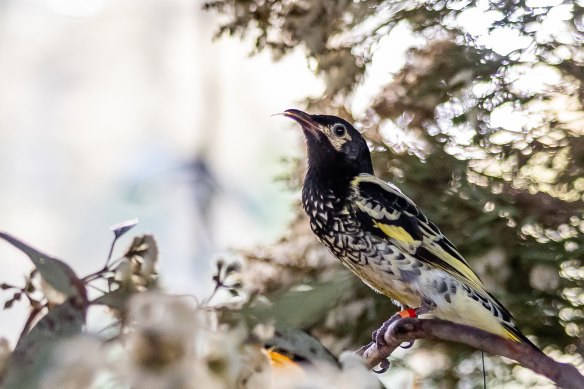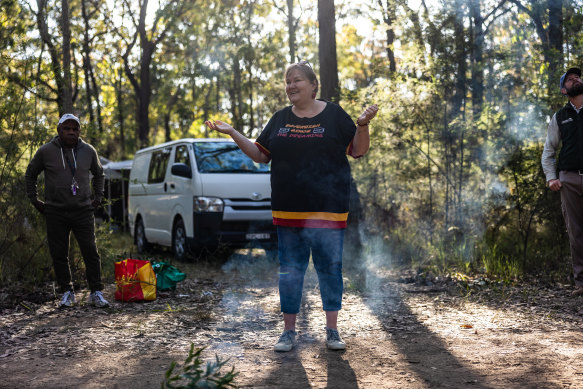
The analysis showed releasing 100 zoo-bred birds every two years is crucial for staving off extinction. Over the next five years breeding success in areas threatened by development in the Hunter Economic Zone and the raising of the Warragamba Dam will make or break the species.
Taronga has bred 600 regent honeyeaters since their conservation program began in 2000, but their honeyeaters were singing an altered mash-up of trills, clicks and mimicked calls of other inhabitants of the zoo such as friarbirds.

The released birds will be tracked for 10 weeks before their tracking harnessed break off.Credit:Alex Pike
Now, adult regent honeyeaters skilled in the NSW song style are housed with young birds so the fledglings learn the right tune, reinforced with wild birdsong played through speakers.
Birds are raised in large aviaries with other species of parrots, honeyeaters and fruit doves the regent honeyeaters have to compete against for food and shelter. They feed from native plants, practise “hawking” for insects and are provided with spider webs, which they use to bind twigs and leaves together for nests.
“There’s an element of having to fend for themselves and toughen up, compared to if you imagine an aviary which has a few regent honeyeaters which are getting fed out of a dish,” Elphinstone said.
After 58 song-tutored birds were released last year, they started building nests within four days and zoo-bred birds mingled with wild flocks. Two of the zoo-bred birds successfully reared a chick. The hope is wild and captive-bred birds will start to breed together too.

Chief executive of the Mindaribba Local Aboriginal Land Council Tara Dever, whose organisation has facilitated bush regeneration and the honeyeater release.Credit:Alex Pike
BirdLife’s Mick Roderick said a delay in the blossoming of eucalypts in the Lower Hunter breeding area meant no wild or released birds from last year had been spotted this season.
“We found about 40 nests last year,” Roderick said. “And now we can’t even find a single bird. That gives you an idea of just how in trouble this bird is.”
But long-flowered mistletoe, which the honeyeaters feed and build their nests on, is blossoming in the release area. The mistletoe was destroyed by fires in 2016 and 2017, but hundreds of plants were restored in a painstaking restoration program that saw arborists climb into the canopy and plant 1000 mistletoe seeds - which are as “sticky as superglue” - on the underside of branches. But the honeyeaters need both the mistletoe and the blossoming eucalypt to breed.
Loading
The restoration project was facilitated by the Mindaribba Local Aboriginal Land Council and the honeyeater release, funded by the NSW government’s Saving our Species program, took place on Wonnarua Country.
“This Country, like its people and this wonderful bird, has survived massive change and upheaval over the past 250 years,” the council’s chief executive Tara Dever said.
“While conditions need to be just right, to ensure the birds have enough food and shelter, the deep connection between First Nations People and this land has assisted with the success of the release.”
Get to the heart of what’s happening with climate change and the environment. Our fortnightly Environment newsletter brings you the news, the issues and the solutions. Sign up here.









 Add Category
Add Category